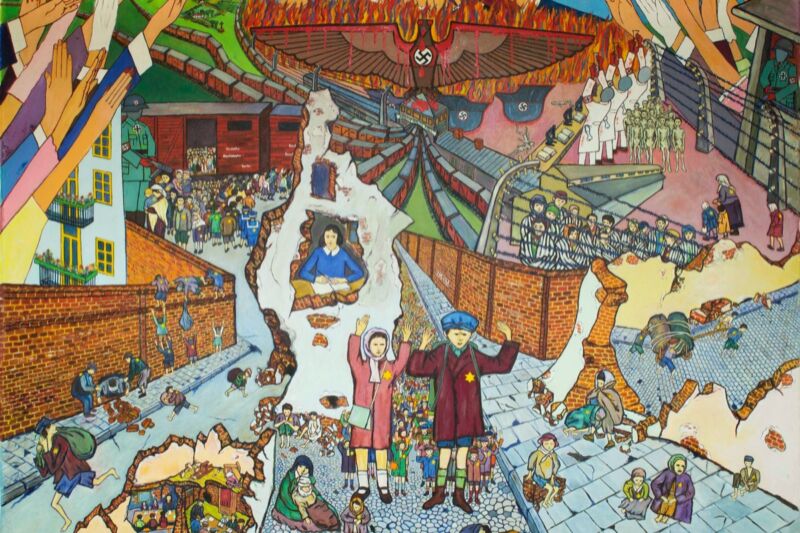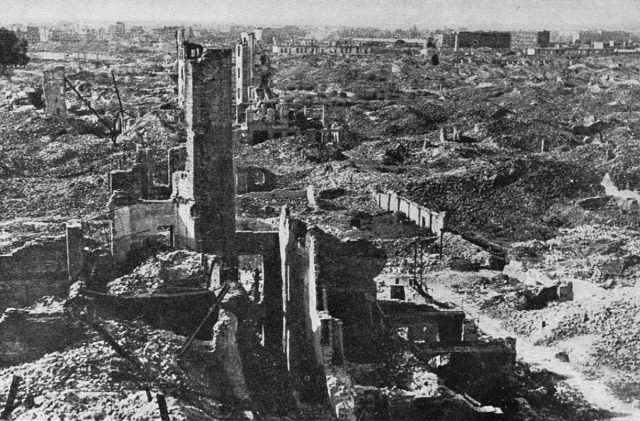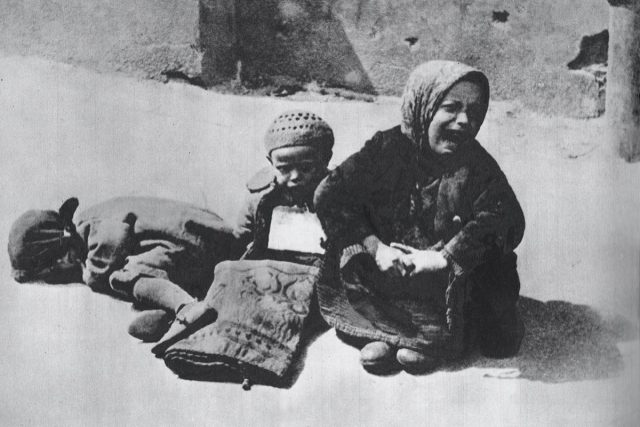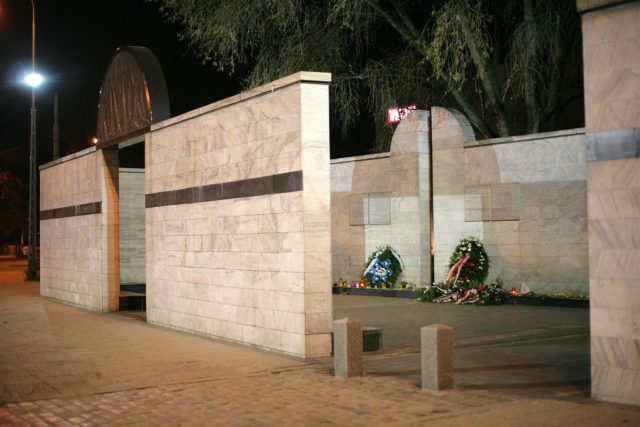Bending the curve in 1941 —
Social distancing, self-isolation, underground training of medical students were key.
Jennifer Ouellette
–

Enlarge / Painting by Israel Bernbaum depicting Jewish children in Warsaw Ghetto and in the death camps (1981).
Monclair State University collection
During the Nazi occupation of Poland during World War II, Jewish residents in Warsaw were forcibly confined to a district known as the Warsaw Ghetto. The crowded, unsanitary conditions and meager food rations predictably led to a deadly outbreak of typhus fever in 1941. But the outbreak mysteriously halted before winter arrived, rather than becoming more virulent with the colder weather. According to a recent paper in the journal Science Advances, it was measures put into place by the ghetto doctors and Jewish council members that curbed the spread of typhus: specifically, social distancing, self-isolation, public lectures, and the establishment of an underground university to train medical students.
Typhus (aka “jail fever” or “gaol fever”) has been around for centuries. These days, outbreaks are relatively rare, limited to regions with bad sanitary conditions and densely packed populations—prisons and ghettos, for instance—since the epidemic variety is spread by body lice. (Technically, typhus is a group of related infectious diseases.) But they do occur: there was an outbreak among the Los Angeles homeless population in 2018-2019.
Those who contract typhus experience a sudden fever and accompanying flu-like symptoms, followed five to nine days later by a rash that gradually spreads over the body. If left untreated with antibiotics, the patient begins to show signs of meningoencephalitis (infection of the brain)—sensitivity to light, seizures, and delirium, for instance—before slipping into a coma and, often, dying. There is no vaccine against typhus, even today. It’s usually prevented by limiting human exposure to the disease vectors (lice) by improving the conditions in which outbreaks can flourish.
A scourge for centuries
Something very like typhus was first described in 1489 CE during the War of Granada, in which the Spanish army reported losing 17,000 men to disease. In 1577, an assizes held in Oxford, England (now known as the Black Assizes), led to an outbreak that killed over 300 people after infected prisoners were brought into the court and spread the disease to the members. By 1759, nearly a quarter of English prisoners were dying of gaol fever. There were fatal outbreaks during Napoleon’s retreat from Moscow in 1812, during the Irish famine between 1816 and 1819, in Philadelphia in 1837, and all along the Eastern Front during World War I.
Yet another outbreak spread through much of Europe during the Russian Revolution. An estimated 30 to 40 million people contracted the disease in Russia alone, according to co-author Lewi Stone of RMIT University and Tel Aviv University, and between 3 million and 5 million died. Typhus proved to be an equally deadly scourge during World War II, particularly in Nazi-occupied cities and concentration camps. (Anne Frank and her sister, Margot, died of typhus at Bergen-Belsen at the ages of 15 and 19, respectively.)

Enlarge / Ruins of the Warsaw Ghetto, circa 1945.
Nearly 450,000 Jewish residents were packed into the 3.4 kilometers of the Warsaw Ghetto and rationed a meager 200 calories per day, with little soap and water to keep clean. “With poor conditions, rampant starvation and a population density 5 to 10 times higher than any city in the world today, the Warsaw Ghetto presented the perfect breeding ground for bacteria to spread typhus, and it ripped through the mainly Jewish population there like a wildfire,” said Stone. “Of course, the Nazis were well aware this would happen.” The paper cites a 1941 document by ghetto commissar Heinz Auerswald noting a “quantum leap” in May deaths, for example, and the situation became so bad that the streets were littered with human corpses covered in newspapers.
Stone et al. point out that the widespread extermination of Jews was partly triggered (or at least rationalized) by public health concerns—a convenient pretext to commit genocide. The paper quotes an October 1941 statement by Jost Walbaum, chief health officer of occupied Poland, calling Jews “carriers and disseminators” of typhus, and offering two solutions. “We sentence the Jews in the ghetto to death by hunger or we shoot them…. We have one and only one responsibility, that the German people are not infected and endangered by these parasites.” The authors note that his comments were met with enthusiastic applause, adding, “Today, more than ever society needs to grasp how a virus or bacterium can create utter havoc, dragging humankind to this terminal point of evil.”
“Today, more than ever, society needs to grasp how a virus can create utter havoc, dragging humankind to this terminal point of evil.”
Stone is a mathematical biologist who has been modeling diseases for decades, a research area that includes reconstructing past epidemics and pandemics, like the Black Death that ravaged Europe in the 14th century, the Spanish Flu of 1918, or more recently, the outbreak of Zika in Brazil before the 2016 Olympic Games. He came across an article that mentioned outbreaks of typhus during World War II and wanted to learn more. After he found some data on typhus in the Warsaw Ghetto, he plotted it on his computer.
It proved challenging to find additional information, however. Ghetto residents often avoided reporting such diseases. That was because the Nazis typically responded with extreme measures, like injecting phenol into the hearts of those who were sick, killing them instantly, or burning a hospital to the ground, patients still inside, because they were infected with typhus.
That said, according to Stone, there were many experienced doctors housed in the Warsaw Ghetto, some of whom survived the war, and they documented the various measures taken to battle the typhus outbreak. He visited libraries all over the world, scouring their archives for relevant documents that might provide more details about the kinds of strategies deployed.

Enlarge / Homeless children in the Warsaw Ghetto, circa 1941.
“We know that in other towns of the region, typhus continued on through the winter unabated,” said Stone, citing historical records. “So it was odd that just in the Warsaw Ghetto, the disease should die out before winter when it was expected to accelerate. Thus, we are fairly confident that the intervention succeeded.” He admitted being surprised by that finding and initially assumed it was the result of a corrupted data set. But the diary of Polish historian and Warsaw Ghetto resident Emanuel Ringelbaum provided corroborating evidence. Ringelbaum documented the day-to-day happenings in the ghetto and reported a 40-percent drop in the epidemic rate at that time, calling it “irrational.”
Stone and his co-authors thought their mathematical models might shed some light on this oddity. The model revealed that there must have been some kind of behavioral change factor, since without it, the epidemic would have peaked in the middle of winter (January 1942) and been as much as two to three times larger. Epidemics typically collapse when there aren’t enough susceptible (uninfected) people in a given population to sustain the spread. But less than 10 percent of the Warsaw Ghetto residents had been infected when the outbreak died down in late October of that year.
The ghetto doctors and council members encouraged (and even enforced, when necessary) general good hygiene and cleanliness, despite the terrible conditions. They encouraged social distancing, and those sickened were quarantined. The community even managed to open up soup kitchens, smuggling in extra food to augment their rations. There were public lectures to educate the residents about the importance of such measures and even a rudimentary underground university to train new doctors. Stone et al. estimate that these measures likely prevented as many as 100,000 people from contracting typhus and tens of thousands from dying of the disease.
Nonetheless, Stone was astonished at the sheer number of typhus cases predicted by their model—100,000 infected people over the course of the epidemic—compared to the official reported numbers. And the official number of recorded deaths from typhus and starvation didn’t match what he was reading in diaries and reports of the ghetto’s epidemiologists, corroborated by a mathematical analysis of food ration cards (the subject of a forthcoming paper) that were handed out to all the ghetto residents each month. “We believe there were far more deaths in 1941 than realized,” Stone said, mostly due to typhus, starvation, or both combined, since the two formed a deadly feedback loop.
Lessons for COVID-19

Enlarge / National monument at the Ghetto’s former Umschlagplatz—the term used to denote the holding areas adjacent to railway stations, where Jews from ghettos were assembled for deportation to Nazi death camps—symbolizing an open freight car. Stawki Street, Warsaw.
According to Stone, there are striking similarities between that 1941 typhus outbreak and the current COVID-19 pandemic. A bacteria or virus spreads and causes widespread havoc, breaking up the social fabric of the community. “In the Warsaw Ghetto, the hospitals completely lacked resources, became overcrowded with a shortage of beds, there was no food and unchecked starvation,” said Stone. There was also a strong effort to set up quarantines when necessary and efforts to produce a vaccine. “I find what happened in the Warsaw Ghetto a microcosm of COVID-19 days, or, it seems, rather like a parallel universe, at least in terms of contagion and its outcomes.”
The two diseases are still different, however. Typhus is a bacterial disease spread by lice, in contrast to COVID-19, which spreads mainly from person to person, typically through respiratory droplets from coughing, sneezing, or talking. The latter is more contagious, but typhus is more deadly, per Stone, so it’s not clear whether the exact same mitigation methods that helped control typhus in the Warsaw Ghetto would be equally effective against COVID-19—especially given how politicized the current outbreak has become. “This was, after all, a period when medical experts were in fact respected and their advice heeded,” Stone said. “The methods perfected by infection disease experts from centuries of dealing with these pandemic-like events are our best defense.”
“As those in the Warsaw Ghetto demonstrated, the actions of individuals in practicing hygiene, social distancing, and self-isolating when sick can make a huge difference within the community to reduce the spread,” concurred co-author Yael Artzy-Randrup of the University of Amsterdam. “It is the cooperation and active recruitment of communities that beat epidemics and pandemics, not government regulations alone.”
Tragically, all those community measures based on sound medical knowledge couldn’t save the surviving residents of the Warsaw Ghetto from the occupying Nazis, who started deporting them to the concentration camps soon after. At least a quarter of a million Warsaw Jews were deported to Treblinka in the summer of 1942 alone. (Only Auschwitz boasted higher death tolls.) Those who were not deported resisted when the second wave of deportations began in January 1943—known as the Warsaw Ghetto uprising. The Nazis crushed the insurrection a few months later, burning and blowing up the buildings block by block, and capturing or shooting any Jewish people they could find. It’s a sobering reminder of the staggering capacity of man’s inhumanity to man that, frankly, feels especially relevant right now.
DOI: Science Advances, 2020. 10.1126/sciadv.abc0927 (About DOIs).

